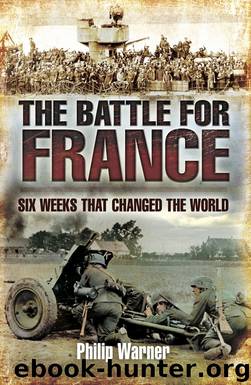The Battle for France by Philip Warner

Author:Philip Warner
Language: eng
Format: epub
ISBN: 9781783469048
Publisher: Pen and Sword
Published: 2013-09-25T16:00:00+00:00
14
The Battles for Calais and Boulogne
ON 19 MAY both Calais and Boulogne appeared to be safely in Allied hands and unlikely to experience more than bombing; however, if the general situation continued to deteriorate either or both might have to be used for evacuating non-essential troops from elsewhere. The arrival of Guderian’s Panzers in the neighbourhood caused a rapid reappraisal of these ideas. Realising that the two ports had suddenly become highly vulnerable, the War Office sent out anti-aircraft guns, the 3rd Royal Tank Regiment, and the Queen Victoria Rifles, who arrived with no transport and few weapons. On 23 May these were joined by 2nd Battalion King’s Royal Rifle Corps (60th Rifles), also then known as the Greenjackets, and 1st Battalion The Rifle Brigade.
The commander of this small but stout-hearted force was Brigadier Claude Nicholson. He was well aware that most of his troops had never seen any form of action, that they had insufficient weapons, and that the most critical shortage was in tanks and field artillery. They would soon be confronted by the experienced 10th Panzer Division, which had considerable battle experience, artillery of every variety, and powerful aerial support. The odds would still have been overwhelmingly in favour of the Germans even if Nicholson had been sent the artillery and ammunition he requested. The only commodity which he had in abundance was absurd orders; the War Office, aware that it had no control over the main battle, was determined to show that in this area, at least, it could make an attempt to demonstrate its authority. Nicholson was therefore informed that he should help the hard-pressed garrison in Boulogne but in the same breath that he should be ready to assail the troops around St Omer. He was told that his forces must be evacuated immediately and then that they should stay and fight to the end. Meanwhile he could see the destroyers in Calais harbour which had been ordered to stand by and wait for the evacuation.
The muddles seem almost incredible, even allowing for the confusion created by the general situation. There was a critical shortage of arms and ammunition, which had been left behind because of an alleged lack of space in the transports; and most of the anti-tank guns which would have been invaluable in the defence of Calais were still on the dockside at Dover. Even more astonishing was the fact that when the troops had been put ashore at Calais their ships were sent home before they had completed unloading what stores they had been able to bring with them. Incredulously they watched these vessels depart carrying their essential needs.
In recent years Calais and the surrounding countryside have become familiar to large numbers of people who have visited the area as tourists. Although much of the town, including the old part, was destroyed during the war, most of it has been rebuilt. The town lies in flat country and is overlooked by a ridge of high ground to the south-west from
Download
This site does not store any files on its server. We only index and link to content provided by other sites. Please contact the content providers to delete copyright contents if any and email us, we'll remove relevant links or contents immediately.
The Radium Girls by Kate Moore(10928)
The Templars by Dan Jones(4199)
100 Deadly Skills by Clint Emerson(4093)
Rise and Kill First by Ronen Bergman(4026)
The Doomsday Machine by Daniel Ellsberg(3743)
The Rape of Nanking by Iris Chang(3530)
Killing England by Bill O'Reilly(3467)
Hitler in Los Angeles by Steven J. Ross(3450)
Stalin by Stephen Kotkin(3095)
12 Strong by Doug Stanton(3064)
Hitler's Monsters by Eric Kurlander(2741)
Darkest Hour by Anthony McCarten(2655)
Blood and Sand by Alex Von Tunzelmann(2615)
The Art of War Visualized by Jessica Hagy(2424)
Hitler's Flying Saucers: A Guide to German Flying Discs of the Second World War by Stevens Henry(2306)
The Code Book by Simon Singh(2222)
The Second World Wars by Victor Davis Hanson(2140)
Babylon's Ark by Lawrence Anthony(2078)
Tobruk by Peter Fitzsimons(2068)
